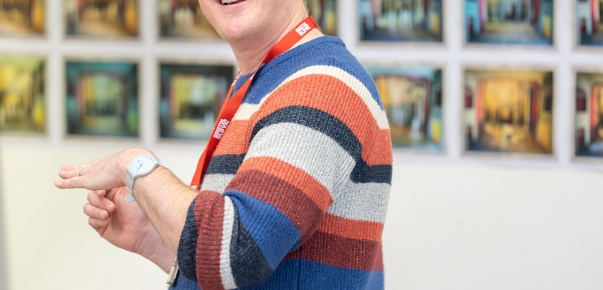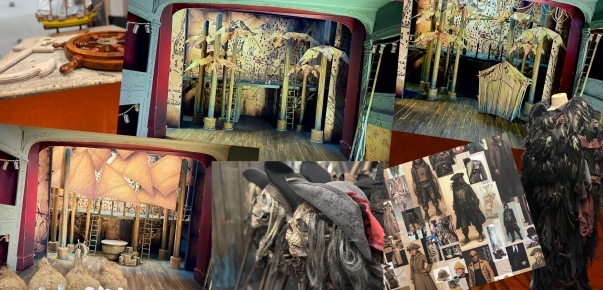An interview with Miranda Cromwell, Director of Hey Diddle Diddle
20 Nov 2012We met Miranda Cromwell, Director of Hey Diddle Diddle, who is creating a musical festive wonderland for younger audiences in Bristol Old Vic’s Studio this Christmas.
Tell me about Hey Diddle Diddle.
It’s about play: it’s about how we learn to play, why we play; joining in with games, being left out, and choosing who’s the leader and what game you’re going to play. It’s about remembering what it’s like to hear nursery rhymes, but hearing them retold in different ways. It’s about the discoveries that we all experience: of building a den, making an obstacle course, singing to each other and learning things.
The show is told primarily through music and dance, and looks at how young children respond to action and sound and symbolic language and drawing, through to forming words, remembering words, patterns and sounds. It links the world of the imagination to the way that we play.
How did you research the show?
The first place I looked was TheOxford Dictionary of Nursery Rhymes by Iona and Peter Opie, who created a collection of nursery rhymes and games. It collates children playing throughout the years, and the rhymes that stick, and why they stick, and the different ways the rhymes fluctuate in different regions of the country.
My original inspiration for doing the show was based on the Reggio Amelia approach, which is based on a system of pre-school learning in Italy. It’s child-centred and is about documenting the way in which children play, what they chose to investigate and what they are curious about, facilitating their imagination and therefore facilitating their learning through lots of different subjects without a curriculum. It basically looks at the ways you can teach through play and how you can learn through play.
The show has been driven by nursery rhymes but also children’s games, songs, basic patterns. We’ve run lots of workshops in nurseries and schools looking at how children of different ages react to the rhymes and other provocations, which ones they’re singing, which ones they don’t know, what captures their imagination.
Which nursery rhymes appear in the show?
We’ve got a lovely version of Twinkle Twinkle Little Star which has five verses, and Hickory Dickory Dock, Incy Wincy Spider, Little Miss Muffet, Humpty Dumpty, The Grand Old Duke of York. And then other song rhymes like There Were Ten In The Bed…
The premise is that there are three children, who creep down to play in the middle of the night. They discover in their play room a magic trunk which they try to open. Inside the trunk are these rhymes, so the trunk is musical and there are instruments, and music creeps out of the trunk and they find different worlds of adventure. Eventually they build a den and transform the space so they end up sitting under the night sky. It transforms into a magical space…
Sounds exciting. Has it been for you, too?
It has been very exciting to be working with the different members of the creative team and cast. There are so many different techniques and disciplines going on in the room, through Elizabeth Westcott with the music, through Adam Peck who is looking at storytelling and narrative structure. Our cast members are all primarily dancers so there is an inherent abstraction to the world, the sound and the action, which is really exciting and interesting to pin to a meaning and context for young children, and for an audience to understand. That interplay between logic and illogic is really fun.
The action can descend into total nonsense and silliness, but we always bring it back to something that is familiar, about family, about the way siblings are with each other, about play, feelings of loneliness or being part of a community, as well as being a turkey on a hill, or losing your sheep or jumping over the moon.
What is there for adults in this performance?
As adults, we have found it absolutely hysterical looking through some of the scenarios and sequences. The performers are taking everything they do very seriously in terms of the world of play, but from outside these are also hilariously illogical and really funny to watch. I think that a combination of watching children respond to the work, and the work itself being so surreal is a really enchanting thing.
You are also the Young Company director at Bristol Old Vic, how is this influencing the show?
I teach a lot, and run a lot of sessions, which gives me lots of space to test out ideas and get them involved in creating material for a show. Working with lots of different ages and groups always reminds me of the audience and makes me think about what’s interesting for audience and not just for yourself. It’s also fascinating working with their ideas, as things that I’ve never even thought about or considered come up. It gives me a space to work through ideas in a space where there is less pressure, and we find really exciting ideas.
What’s next for you?
As well as this, we are also rehearsing our Bristol Old Vic Young Company show, The Life After, which opens in February. It has over a hundred performers, including members of our new adult company, which is really exciting. We’re re-imagining the scratch show we did in the Studio last summer, and to celebrate the glorious space and the wonderful Theatre we live in.
Hey Diddle Diddle is on at Bristol Old Vic from the 28th November until the 9th of January. You can find out more about the show on our website: www.bristololdvic.org.uk







